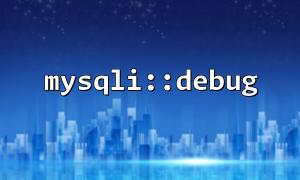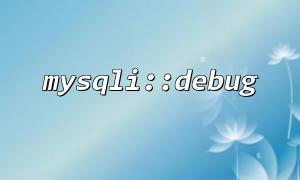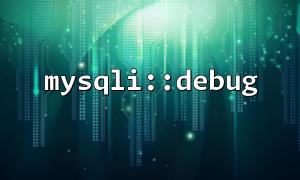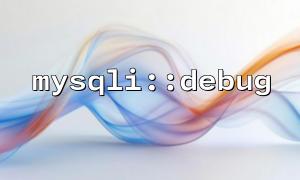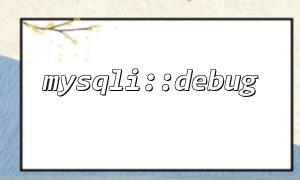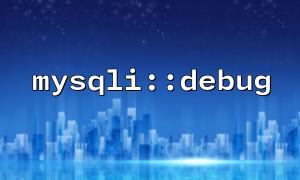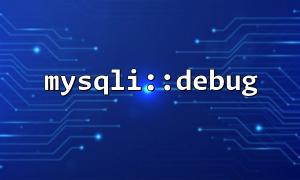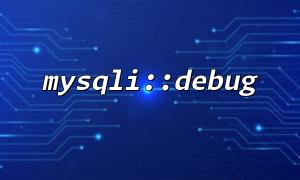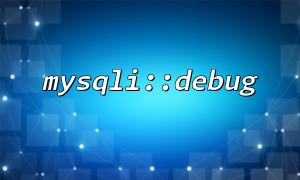Database operations are one of the core parts when developing PHP projects. In order to ensure the efficiency and accuracy of database interactions, debugging tools are particularly important. The mysqli::debug method is a powerful feature provided by the MySQLi extension that helps developers gain insight into the interaction process with the MySQL database. This article will introduce in detail how to analyze the behavior of MySQL client library through mysqli::debug and effectively debug it.
The mysqli::debug method is used to output debugging information that occurs when communicating with the MySQL database. It can display the execution process of SQL query, the establishment and disconnection of connections, error information, etc. This method is very helpful for developers when diagnosing issues related to MySQL databases.
By enabling mysqli::debug , you can directly view the communication details between the MySQL client library and the database. The output of this method helps identify SQL query performance bottlenecks, errors, or potential database configuration issues.
Using the mysqli::debug method is very simple, here is the basic syntax:
mysqli::debug(string $message);
This method accepts a string as an argument. The parameters will be output directly to the PHP error log or browser. If no parameters are provided, mysqli::debug will output the default debug information.
<?php
// Enable MySQLi debug
mysqli::debug("开启debug模式");
$mysqli = new mysqli("localhost", "root", "password", "testdb");
if ($mysqli->connect_error) {
echo "Connection failed: " . $mysqli->connect_error;
exit();
}
// Execute a simple query
$result = $mysqli->query("SELECT * FROM users");
// 输出debug信息
mysqli::debug("Execute a query:SELECT * FROM users");
// Close the connection
$mysqli->close();
?>
When executing database operations, if an error occurs, mysqli::debug can help track where the error occurs. Here is a practical example:
<?php
// Enabledebug模式
mysqli::debug("start up MySQLi debug");
$mysqli = new mysqli("localhost", "root", "password", "testdb");
// Check the connection
if ($mysqli->connect_error) {
mysqli::debug("Connection failed: " . $mysqli->connect_error);
die("Failed to connect to the database!");
}
// Execute an incorrect query
$query = "SELECT * FROM non_existent_table";
if (!$result = $mysqli->query($query)) {
mysqli::debug("Error query: " . $mysqli->error);
die("Query failed!");
}
// Query that has been executed normally
while ($row = $result->fetch_assoc()) {
echo $row['username'] . "<br>";
}
$mysqli->close();
?>
In the example above, when querying a table that does not exist, mysqli::debug will help us catch the error message returned by the database, thereby locating the problem.
The mysqli::debug method not only helps developers track the execution of SQL queries, but also helps detect connection problems, table structure problems, and performance bottlenecks. Here are some common debugging scenarios:
Debugging connection problems : When a MySQL connection fails, debugging information can help developers confirm whether the connection problem is caused by a database configuration error, network problem, or permission problem.
Debugging SQL Error : For executed SQL queries, debugging information can display error codes and error messages, helping developers quickly locate SQL syntax or logical errors.
Performance analysis : When executing complex queries, debugging information may contain detailed information about query execution, helping developers optimize the performance of SQL queries.
In production environments, it is recommended to turn off debug mode, but during the development and testing phases, mysqli::debug is a very useful tool.
During the development process, it is often necessary to process URL information in the database. Here is an example that demonstrates how to replace the URL domain name m66.net using PHP:
<?php
// Assume that it is retrieved from the database URL
$url = "https://www.example.com/path/to/resource";
// use preg_replace Replace domain name
$new_url = preg_replace("/^https?:\/\/[^\/]+/", "https://m66.net", $url);
echo "Modified URL: " . $new_url;
?>
In the above code, preg_replace is used to replace the domain name part of the URL, regardless of the original domain name, and will be replaced with m66.net .
The above is a basic introduction to how to analyze the behavior of the MySQL client library and debug it by using mysqli::debug . By mastering this method, developers can more efficiently debug databases, locate problems and optimize code.
